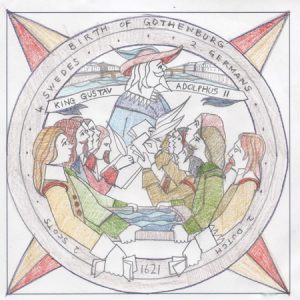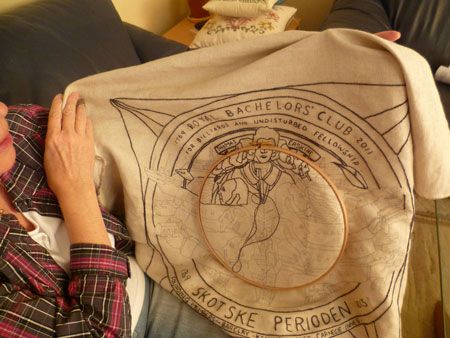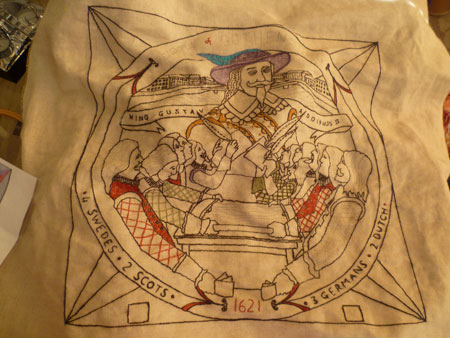Getting Started
Step by step to a completed Diaspora panel

1. Stories. Please send us your story. This could be about your ancestors leaving Scotland and making a new life elsewhere, or perhaps you have recently emigrated from Scotland. We would also like to see photographs, copies of documents etc. We might want to tell your story and share your images on this website, so make sure that you include permission for us to do so!
2. Research. It is very important to us that the tapestry is historically accurate. You are better placed to verify the historical information in your stories than us: why not get in touch with local historians and heritage groups for help? If you are an historian, an academic or a member of an historical/heritage society with access to researched material, then get involved! We want you to help us identify key elements of the diaspora that should be included in the panels, to assist us with verification of the drawings before they are stitched? Perhaps you could make a contribution to our website?
3. Design. Here’s what we need to reach the next step:
Important people, events, places, quotations etc associated with your/your community’s story and should be included in the panels, with concise and accurate information supporting these stories. We want you to tell us what stories are important to you!

– Images that the designer can refer to should be sent as .jpegs where possible.
– Accurate images of buildings, landscapes, patterns, motifs, monuments, handwritten letters, plants, garments and images of relevant objects such as weaponry, tools, trade items.
– Photographs of people are important for an accurate representation of clothing, hair and so on of the day.
But please note that embroidered panels cannot recreate precise portraits, although embroidered text can identify individuals and photographs can be incorporated into the associated information on the website.
– Your personal stories and associated images for design inspiration (and inclusion on the website archive).
4. Drawing. Once we have the information above, our designer will make a small sketch of the proposed panel which will then be sent to you/your group for verification. If there are any errors, omissions or further suggestions then simply let us know! The designer will then create the final drawing and you will receive a copy of this along with linen, wool and instructions for creating the panel. If you have some initial ideas for how you might want your panel to look, then let our artist know by sketching them onto the Tapestry Template below: he can then use your thoughts as inspiration towards the final look of the panel artwork!
5. Stitching! No experience is necessary, only enthusiasm! Would you like to share the stitching of a panel with others in your community? You will receive the linen with the design pre-drawn on in pencil, along with wool and a reference drawing. Each panel will measure 50cm x 50cm. You will also receive some basic embroidery stitch instructions, and additional help can be found online – and of course the advice of fellow stitchers is always indispensable. Have a look at our Facebook page to see how other stitchers are getting on, and feel free to ask them for ideas or advice.

You can download the Stitching Guidelines here.
6. Blogs. As well as the stitchers’ forum, the website also has blog space for each country’s stitchers to report on their progress. Make sure you upload regular updates and photographs, sharing your experience and progress as your panels begin to emerge! Who knows what inspiration we will all gain from each other.
7. Completion. You will be given your deadline date allowing you 3 months to stitch the panel. The finished panel will be prepared at Prestonpans for display.
Timescales
January 2013 – November 2013
Submission of personal stories, researched material and images to Yvonne Murphy / Gillian Hart. Please contact Yvonne or Gillian as soon as possible for your deadline date. Material received after this date will go onto the website as part of the archive and depending on time constraints may still be included as part of the panel designs.
December 2012 – December 2013
Initial sketches of the panels will be designed and sent to the diaspora communities for verification. Participants are encouraged to contribute to the design at this stage. Notify us of any errors, is there anything missing from the design, is something/someone incorrectly portrayed as we want you to be happy with the way your story is told?
May – 30 December 2013
The panel kit will be sent to the stitchers. Completed panels should be returned by the deadline given on receipt of the kit to allow time for the preparation of the panels for display.
November – March 2014
Panels prepared for exhibition.
January – December 2014
Year of the Homecoming,
featuring the first full exhibitions of the Scottish Diaspora Tapestry.
2015 and beyond…
Tours and exhibitions across the globe! See our Exhibitions page.

